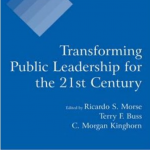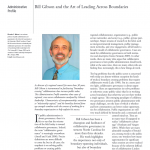Topic: Public Leadership

From Local Managers to Community Change Agents: Lessons From an Executive Leadership Program Experience
Since fall 2003, the Public Leadership faculty of the University of North Carolina at Chapel Hill (UNC) School of Government (SOG) has worked on the design and delivery of the Public Executive Leadership Academy (PELA), an advanced leadership program for local managers. PELA serves a diverse audience of twenty-five municipal and county managers, assistant managers, and department heads who aspire to leadership careers in local government and need to hone or develop their communication and collaboration skills. The program’s curriculum is unique in its focus on the manager’s role as community leader and change agent, and its emphasis on leading and managing in an intergovernmental and intersector context. Participants apply information and insights from class sessions to their “real world” change opportunity back home. To our knowledge, no other university-based public executive leadership program in the United States has this emphasis. As we reflect on the past two years of experience, we have learned a great deal. The purpose of this chapter is to share these lessons with those interested in developing similar leadership programs. Our focus is on: (1) partnership management, (2) collaboration, (3) curriculum design, (4) team-building techniques, and (5) program evaluation.
Cite as:
Morse, Ricardo S., and Terry F. Buss. Innovations in Public Leadership Development, Routledge, 2008. ProQuest Ebook Central, http://ebookcentral.proquest.com/lib/unc/detail.action?docID=1900028.
Created from unc on 2019-04-05 11:47:52.
…
Continued
Visions of Leadership: An Examination of How IT Professionals Prioritize Leadership Attributes
Chief Information Officers (CIOs) are a transforming public sector leadership group. CIOs have emerged
to connect business units in an organization with information technology staff. They are the linchpin between the seemingly disparate, and often contentious, components of an organization. The potential impact of this population is high but their characteristics and perspectives have been only nominally explored. By investigating leadership within the public sector IT profession through the application of Q-methodology and use of a well-accepted competing values framework, this article contributes to both the leadership and IT scholarship. Using a sample of local government CIOs from North Carolina, Q-methodology is used to examine how individuals view and operationalize the concepts of leadership in their own work and careers. The research reveals four dominate leadership conceptualizations amongst local government IT professionals. These groupings demonstrate high variation in how IT professionals understand and prioritize leadership attributes.
Cite as:
Tufts, Shannon and Jacobson, W. 2010. “Visions of Leadership: An Examination of How IT Professionals Prioritize Leadership Attributes,” Journal of Information Technology Management. Volume XXI, Number 1. 1-1
…
Continued
Transforming Public Leadership for the 21st Century
This book explores what this shift looks like and offers guidance on what it should look like. Specifically, the book focuses on the role of career leaders: those in public service who are change agents not only in their organizations but also in their communities and policy domains. These leaders work in network settings, making connections and collaborating to create public value and advance the common good.
Cite as:
Morse, Ricardo S., Terry F. Buss, and C. Morgan Kinghorn, eds. 2007. Transforming Public Leadership for the 21st Century. New York: Routledge.
…
Continued
Focusing the Public Leadership Lens: Research Propositions and Questions in the Minnowbrook Tradition
Although there is no shortage of general studies and theories of leadership, the same cannot be said for public leadership. This concern surfaced as a critical issue among scholars at the 2008 Minnowbrook III conference. Drawing from that discussion, this article calls for invigorating the study of public leadership within public administration (PA). We present the case for public leadership, that is, leadership for the public good, where challenges are complex, stakeholders are many, values are conflicting, and resources are limited. Traditional, generic models of leadership—as in, leading followers toward some specific goal—do not align well with these current challenges. We argue for studying public leadership specifically, rather than trying to retrofit existing concepts of leadership from business management or elective politics. PA should be the leading voice in understanding and promoting public leadership. By examining previous public leadership scholarship through three broad lenses—the character of public leadership, the function of public leadership, and the jurisdiction of public leadership—we develop theoretical propositions designed to drive a revitalized research agenda. We conclude with a set of research questions we see as critical to crystallizing the significance of public leadership.
Cite as:
Heather Getha-Taylor, Maja Husar Holmes, Willow S. Jacobson, Ricardo S. Morse, Jessica E. Sowa, Focusing the Public Leadership Lens: Research Propositions and Questions in the Minnowbrook Tradition, Journal of Public Administration Research and Theory, Volume 21, Issue suppl_1, January 2011, Pages i83–i97, https://doi.org/10.1093/jopart/muq069
…
Continued
Integrative Public Leadership: Catalyzing Collaboration to Create Public Value.
Integrative public leadership is a process of developing partnerships across organizational, sectoral and/or jurisdictional boundaries that create public value. This paper explores the concept in the context of the literature and illustrates some salient features of integrative public leadership through three cases involving extensive multi-sector collaboration in the western (Smoky Mountain) region of North Carolina. The cases are different in subject matter—sewer lines to a rural community, broadband infrastructure across a network of rural schools and colleges, and a major environmental preservation effort—but they all share some key elements. Leadership in each case is enacted through structure, process, and people. Boundary organizations provide a structural context for partnership development; boundary experiences and boundary objects serve to bridge differences and create a common purpose; and boundary spanners exhibit entrepreneurial qualities and leverage relationship capital in order to facilitate integration.
Cite as:
Ricardo S. Morse, Integrative public leadership: Catalyzing collaboration to create public value,
The Leadership Quarterly, Volume 21, Issue 2, 2010, Pages 231-245, ISSN 1048-9843, https://doi.org/10.1016/j.leaqua.2010.01.004. (http://www.sciencedirect.com/science/article/pii/S1048984310000238)
…
Continued
Bill Gibson and the Art of Leading Across Boundaries
As director of a regional council for more than 30 years, Bill Gibson is instrumental in facilitating “boundary-crossing” collaborations that increase public value. This Administrative Profile examines three cases of regional, cross-sector collaboration catalyzed by Gibson’s leadership. Characteristics of entrepreneurship, attention to “relationship capital,” and the humility derived from ego strength combine with the context of working for a boundary organization to help explain his success.
Cite as:
Morse, Ricardo. (2010). Bill Gibson and the Art of Leading Across Boundaries. Public Administration Review. 70. 434 – 442
…
Continued
How Public Service Leadership is Studied: An Examination of a Quarter Century of Scholarship
This exploratory study surveys the public service leadership literature from a selection of leading public administration journals over a 25‐year period (1987–2012). Patterns in methods used to study public leadership are explored, along with how those methods vary across settings within the public service sector and the treatment of leadership in the analysis. While the number of empirical studies of public service leadership has grown, the diversity of theoretical approaches, methods and measures challenges the ability to synthesize findings in order to advance the knowledge base on this topic. This article provides a map of leadership studies within the field of public administration over time and offers prescriptions for future research.
Cite as:
CHAPMAN, C., GETHA-TAYLOR, H., HOLMES, M., JACOBSON, W., MORSE, R. and SOWA, J. (2015). HOW PUBLIC SERVICE LEADERSHIP IS STUDIED: AN EXAMINATION OF A QUARTER CENTURY OF SCHOLARSHIP. Public Administration, 94(1), pp.111-128.
…
Continued
